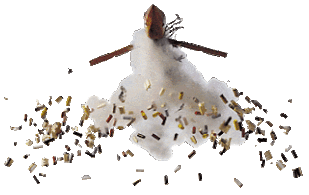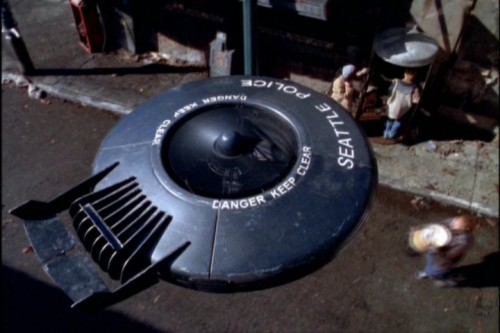One of the warhead types available in Transhuman Space is designated the MBC or Microbot-Biological-Chemical warhead. This is a somewhat misleading label. The minimum mass for a microbot swarm is one pound. Transhuman technical appendix version 3.1.1 tells us “The number of hexes of cyberswarms that a warhead can carry is equal to (bore size/60) cubed.” No units are stated, so millimetres is presumed. 15mm and 30mm missiles both weigh less than 1 lb so 15mm and 30mm MBC warheads and their equivalents cannot contain microbots. They can be used with nanoburn, biochemical agents, gases and various smoke compositions. [TS3e p.158] Perhaps NBC (Nanoburn-Biological-Chemical) is a better term for the smaller calibre rounds.
Hive Bombs
The smallest round listed as carrying a 1-hex/1lb cyberswarm is 60mm. The 60mm recoilless rifle round weighs 6.4lb, so can clearly hold a pound of microbots. Presumably a microbot round would also have to serve as a hive for the cyberswarm. If the round is a high velocity one the swarm may need a cocoon or some other protection against acceleration stresses. Effectively this means a pound of microbots may constitute several pounds of payload. A recoilless round of microbots will also need a guidance and propulsion system. 6.4 lb for a recoilless round holding a 1-hex cyberswarm sounds very credible. A mortar round holding a hex of microbots would need less propellant and is a relatively low velocity projectile. A 60mm mortar bomb weighs 3.2 lb, which sounds about right for a one-hex warhead. As a basic rule of thumb, cyberswarm warheads need to be 60mm or equivalent.
A missile or bomb loaded with a cyberswarm doesn’t necessarily need to be destructive. There are cyberswarms that provide illumination or provide medical attention, cleaning services, repairs or redecoration. It could be a novel way to tag a structure.
Many military weapons release a number of submunitions to attack their target. Submunitions used in TS era weapons are often “smart” and capable of homing in on a target rather falling randomly. While some munitions free-fall some include a capability for powered manoeuvre. It should come as little surprise that some TS weapons use mobots (mobile autonomous robots) as submunitions.
Using mobots as submunitions can greatly increase the capabilities of a weapon system. The use of cyberswarms as warheads is relatively well known so this discussion will be of “swarm warheads” using more sophisticated types of mobot. Munitions used to deploy mobot or microbots are termed hive, swarm or cyber-cargo rounds.

For example, a bomb or missile may contain a number of bumblebots. Superficially this resembles a cyberswarm but the components are capable of independent action. The missile is fired at a building and a few metres from impact it releases the bumblebots. The cloud of bumblebots surrounds the house and exploits any opening large enough for access. They may even exploit damage done by the carrier missile impact. Within seconds scores of bumblebots are within the interior. They dart along the ceiling, ignoring many of the occupants. They have been programmed only to engage a specific target, a notorious drug baron and crime lord. The building’s communications hub is a secondary target and bumblebots that encounter this disable it. During the chaos of the attack some bumblebots conceal themselves in rooms to spy on the aftermath.

Alternately, larger robotic systems can be used as submunitions. In the above scenario the carrier missile might have instead released half a dozen discus-shaped helibots, each armed with several 30mm or 40mm mini-missiles. Many military forces in 2100 make use of jump RATS, cat or dog-sized combat cybershells that can withstand the stresses of being landed in a 2,000lb glide-bomb casing. Various other types of mobot can be deployed by other weapon systems, for a variety of purposes. One of the main design requirements of combat robots may be ensuring they can be packed into commonly used weapon casings.